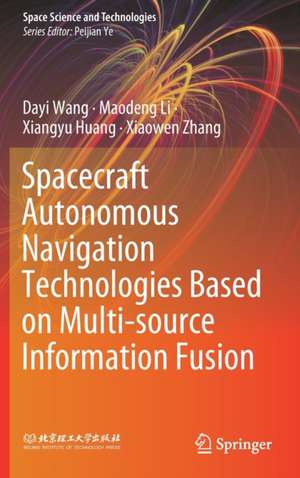Spacecraft Autonomous Navigation Technologies Based on Multi-source Information Fusion: Space Science and Technologies
Autor Dayi Wang, Maodeng Li, Xiangyu Huang, Xiaowen Zhangen Limba Engleză Hardback – aug 2020
| Toate formatele și edițiile | Preț | Express |
|---|---|---|
| Paperback (1) | 1383.31 lei 6-8 săpt. | |
| Springer Nature Singapore – 2 aug 2021 | 1383.31 lei 6-8 săpt. | |
| Hardback (1) | 1389.48 lei 6-8 săpt. | |
| Springer Nature Singapore – aug 2020 | 1389.48 lei 6-8 săpt. |
Preț: 1389.48 lei
Preț vechi: 1694.48 lei
-18% Nou
Puncte Express: 2084
Preț estimativ în valută:
265.91€ • 288.74$ • 223.36£
265.91€ • 288.74$ • 223.36£
Carte tipărită la comandă
Livrare economică 23 aprilie-07 mai
Preluare comenzi: 021 569.72.76
Specificații
ISBN-13: 9789811548789
ISBN-10: 9811548781
Ilustrații: XXI, 340 p. 116 illus., 93 illus. in color.
Dimensiuni: 155 x 235 mm
Greutate: 0.69 kg
Ediția:1st ed. 2021
Editura: Springer Nature Singapore
Colecția Springer
Seria Space Science and Technologies
Locul publicării:Singapore, Singapore
ISBN-10: 9811548781
Ilustrații: XXI, 340 p. 116 illus., 93 illus. in color.
Dimensiuni: 155 x 235 mm
Greutate: 0.69 kg
Ediția:1st ed. 2021
Editura: Springer Nature Singapore
Colecția Springer
Seria Space Science and Technologies
Locul publicării:Singapore, Singapore
Cuprins
Introduction.- Point Estimation Theory.- Estimation Fusion Algorithm.- Performance Analysis.- Time and Coordinate Systems.- Dynamic Models and Environment Models.- Inertial Autonomous Navigation Technology.- Optical Autonomous Navigation Technology.- Optical/Pulsar Integrated Autonomous Navigation Technology.- Altimeter and Velocimeter/Optical Aided Inertial Navigation Technology.- Simulation Testing Techniques for Autonomous Navigation Based on Multi-source Information Fusion.- Prospect for Multi-source Information Fusion Navigation.
Notă biografică
Dayi Wang, Professor, is currently serving as Vice President of the Beijing Institute of Spacecraft System Engineering, CAST. He is a recipient of the National Science Fund for Distinguished Young Scholars and the Chief Technologist of the “973” Project. Dr. Wang has carried out innovative work on spacecraft autonomous navigation and control, making great contributions to the success of China’s Chang’E lunar missions. He received the 2016 Science and Technology Innovation Award from Ho Leung Ho Lee Foundation and has won one National Technological Innovation prize (second class) and several ministerial level prizes (first class 4 times and second class 3 times).
Maodeng Li received his B.S. and Ph.D. degrees in Aerospace Engineering from Harbin Institute of Technology, Harbin, P.R. China, in 2006 and 2011, respectively. From September 2011 to August 2013, he was a Postdoctoral Research Associate at Beijing Institute of Control Engineering(BICE). Since August 2013, he has been a Senior Engineer at BICE. His current research interests include spacecraft autonomous navigation and GNC design for planetary landing missions.
Xiangyu Huang received his B.S. and Ph.D. degrees in Aerospace Engineering from Harbin Institute of Technology, Harbin, P.R. China, in 1999 and 2005, respectively. Since August 2005, he has been working at the Space Intelligent Control Laboratory, Beijing Institute of Control Engineering (BICE), where he is currently a Professor and Senior Research Specialist. He was a GNC Engineer for the Chang’E-3 lunar landing mission, and his current research focus is on GNC design for planetary landing missions. He has won one National Technological Innovation prize (second class) and three ministerial level prizes (first class).
Xiaowen Zhang received his B.E. degree from Harbin Engineering University, Harbin, China, in 2005,and his M.E. degree in Control Theory and Control Engineering from China Academy of Space Technology, Beijing, China, in 2009. He is currently a Senior Engineer at Beijing Institute of Control Engineering. His research interests include GNC system design for deep space exploration missions and spacecraft autonomous navigation and guidance technologies. He has won one first class ministerial level prize.
Textul de pe ultima copertă
This book introduces readers to the fundamentals of estimation and dynamical system theory, and their applications in the field of multi-source information fused autonomous navigation for spacecraft. The content is divided into two parts: theory and application. The theory part (Part I) covers the mathematical background of navigation algorithm design, including parameter and state estimate methods, linear fusion, centralized and distributed fusion, observability analysis, Monte Carlo technology, and linear covariance analysis. In turn, the application part (Part II) focuses on autonomous navigation algorithm design for different phases of deep space missions, which involves multiple sensors, such as inertial measurement units, optical image sensors, and pulsar detectors. By concentrating on the relationships between estimation theory and autonomous navigation systems for spacecraft, the book bridges the gap between theory and practice. A wealth of helpful formulas and various types of estimators are also included to help readers grasp basic estimation concepts and offer them a ready-reference guide.
Caracteristici
Establishes the relations between various estimators to help readers understand them clearly Covers mainstream autonomous navigation technologies for deep space missions Includes numerical simulations, experimental results, and actual flight results











